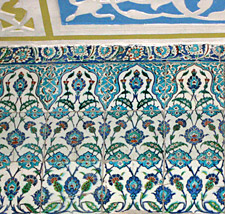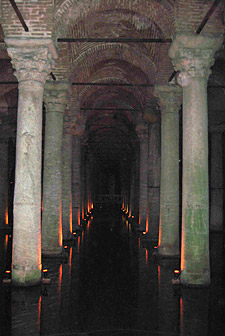Well Day 3 dawned bright and far too early, with the by now familiar ululations of the imams from their minarets wafting over the rooftops, broken only by the insistent shrill of a 5.00am wakeup call. When they said the tour had a busy itinerary they weren't kidding. After dragging my semiconscious body up to breakfast, we boarded the bus headed for the airport for a short flight to AntalyaÅŸ in the region of Pamphilia.
 On the way into Antalya we flew over the Tourus mountain range. The mountains were enormous, huge sharp jagged teeth cutting into the clear blue sky above, with the top third covered in snow and ice. The landscape was barren and looked as though it consisted of harsh granite outcrops, with no vegetation to be seen. Landing an Antalya we drove out to the old ruins of the Hellenistic and later Roman city of Perga. Paul passed through here on his way to missionary work in the northern regions of Galatia, and like us he would have seen enormous city walls interrupted periodically by massive triumphal arches, twenty and thirty metres high.
On the way into Antalya we flew over the Tourus mountain range. The mountains were enormous, huge sharp jagged teeth cutting into the clear blue sky above, with the top third covered in snow and ice. The landscape was barren and looked as though it consisted of harsh granite outcrops, with no vegetation to be seen. Landing an Antalya we drove out to the old ruins of the Hellenistic and later Roman city of Perga. Paul passed through here on his way to missionary work in the northern regions of Galatia, and like us he would have seen enormous city walls interrupted periodically by massive triumphal arches, twenty and thirty metres high.
Wandering through the main city gate the central market place opened up, perfectly square and with a large circular alter devoted to Diana. The entrances to the shops were discernible in the cobbled foundations, zig zagging from shop to shop forcing the consumer to walk through each one to progress down the market place in an early form of directed marketing. One wonders if it was successful in achieving its aims, unlike the current practice of placing escalators in the furthest reaches of the shopping centre in order to force you to lumber past countless shops lugging the all too heavy weekly groceries.
Passing through the central market place a seriously long arcade opened up, stretching several hundred metres in length, and 10 to 15 metres in width. It was once lined with massive columns with carvings and inscriptions staring down at the passers by as they wandered by to do their shopping. Now all that was left were some lonely columns, broken and weathered by the passing centuries, but in the shadows of the remaining columns the former glory of the structures could be seen. Down the centre of the collonade ran a watercourse, a metre wide and running the full length. Cut into the watercourse were a series of steps, which would have provided a river like effect as the water cascaded down its course from one end to the other, also serving to cool the area down on hot summer days.
After the shopping precinct came the social centre of the city, the bathhouse. Three huge rooms were created from conglomerate stones, each the size of a small auditorium. Some of the marble cladding on the walls was still visible, as were a few patches of tiled frescoes from the floor. The furnace area which heated the water for the solarium and the tepidarium was still visible as well, cut into the floor area to provide heat to the patrons while they sat and discussed the issues of the day. The walls each stretched to a height of 30 metres, creating an imposing line along the perimeter of the rooms. The roof would have been magnificent, stretching over the marbled and tiled areas, and crafted from wood cut from the forest outside the walls of the city. Deforestation was obviously not an issue at that time, with the bathhouse going through 40 tonnes of wood per day at full capacity. Nor was equal opportunity a buzzword as women and children were only permitted in the bathhouse in the early hours of the morning after dawn and at the close of the day before sunset, while the men had the luxury of whiling away their days in the steam with nothing to do but talk and pass the time lazing on the benches lining the walls.
Leaving the magnificent old ruins we saw the Greek and Roman inscriptions on the wall left by the long gone inhabitants of the city, and nearly left two of the party behind who lost track of time trying to translate the ancient Greek carvings (not mentioning any names here Bill Salier and cohorts). Driving through the plains of Pamphilia we moved on to the unbelievable stretch of aqueduct, running some 38 kilometres along the plains carrying water to the rich fields below the soaring mountain ranges. The feat of engineering that created a watercourse that ran on a perfectly planned slope from the heights of the water reservoirs in the hills to the lowest parts of the plains was staggering. Standing under the arches of part of the existing stretch of the ancient pipeline was amazing, as you had to crane your neck to see up to the 50 metre top of the stone supports. Sydney Water would certainly have struggled to pull off such a feat.
Later in the afternoon we saw the best preserved Hellenistic theatre in Turkey, an enormous 15,000 capacity stadium in the classic 270 degree ampitheatre of the Greeks, in contrast to the semicircle of the Romans. The seats rose steeply up 40 rows, with standing room at the back under the arches ringing the top of the structure. Due to the precise acoustics our guide, Harkan, was clearly audible from the centre of the stage as we sat on the hard cold marble seats. You'd certainly want to BYO cushion for any lengthy performances though, and it was probably a good thing Wagner's Ring Cycle was still some 19 centuries away.
 The ancient nature of the day's visits were a fitting companion to the sights we had seen the day before in Ä°stanbul. We started at the Blue Mosque, the centrepiece of Islamic tradition in Ä°stanbul. Leaving our shoes at the door, and donning scarves (well, half of us at least), we stepped into the expanse under the four magnificent domes. Excerpts from the Koran lined the walls, fashioned in stunning gold lettering and set against a background of blue mosaics. It was remarkably similar to the Hagia Sophia, which we saw next. Once a Christian church dating back to the sixth century, with the conquest of the Ottomans it was converted in the 15th century to a mosque, yet large parts of its Christian heritage remained. The result is a mix of catholic style friezes of Jesus, Mary and various saints, jostling for space between the same flowing Turkish scripts we had seen in the Blue Mosque. Multiculturalism was certainly alive and well in Ä°stanbul then, as it is today.
The ancient nature of the day's visits were a fitting companion to the sights we had seen the day before in Ä°stanbul. We started at the Blue Mosque, the centrepiece of Islamic tradition in Ä°stanbul. Leaving our shoes at the door, and donning scarves (well, half of us at least), we stepped into the expanse under the four magnificent domes. Excerpts from the Koran lined the walls, fashioned in stunning gold lettering and set against a background of blue mosaics. It was remarkably similar to the Hagia Sophia, which we saw next. Once a Christian church dating back to the sixth century, with the conquest of the Ottomans it was converted in the 15th century to a mosque, yet large parts of its Christian heritage remained. The result is a mix of catholic style friezes of Jesus, Mary and various saints, jostling for space between the same flowing Turkish scripts we had seen in the Blue Mosque. Multiculturalism was certainly alive and well in Ä°stanbul then, as it is today.
 Following on from the Blue Mosque and the Hagia Sohpia we descended into the dark caverns of the Cisterns, the old water storage area for the city. Notwithstanding it was underground and underwater, the designers had created a series of arched columns supporting the ground above under the city surface. Fish swam lazily through the now shallow waters, with the columns showing marks of earlier times when the water level was several metres in height. There were even carvings of Medusa at the base of some columns leaving you to wonder why such an effort was put in to an area that would not be seen by anyone other than the fish who feed on the plentiful algae clinging to the columns in the darkness. You could almost hear Gollum muttering "my preciousssss' in the background, such was the dank and silent nature of the cisterns.
Following on from the Blue Mosque and the Hagia Sohpia we descended into the dark caverns of the Cisterns, the old water storage area for the city. Notwithstanding it was underground and underwater, the designers had created a series of arched columns supporting the ground above under the city surface. Fish swam lazily through the now shallow waters, with the columns showing marks of earlier times when the water level was several metres in height. There were even carvings of Medusa at the base of some columns leaving you to wonder why such an effort was put in to an area that would not be seen by anyone other than the fish who feed on the plentiful algae clinging to the columns in the darkness. You could almost hear Gollum muttering "my preciousssss' in the background, such was the dank and silent nature of the cisterns.
Tomorrow we see more examples of the skill of the Hellenistic and Roman builders as we travel up the coast towards Ephesus. But that comes after another 6am wakeup call, so it's off to bed for some much needed sleep!
Kathryn Roach is part of a group of Moore College students investigating Turkey under the tutelage of Dr Paul Barnett

















